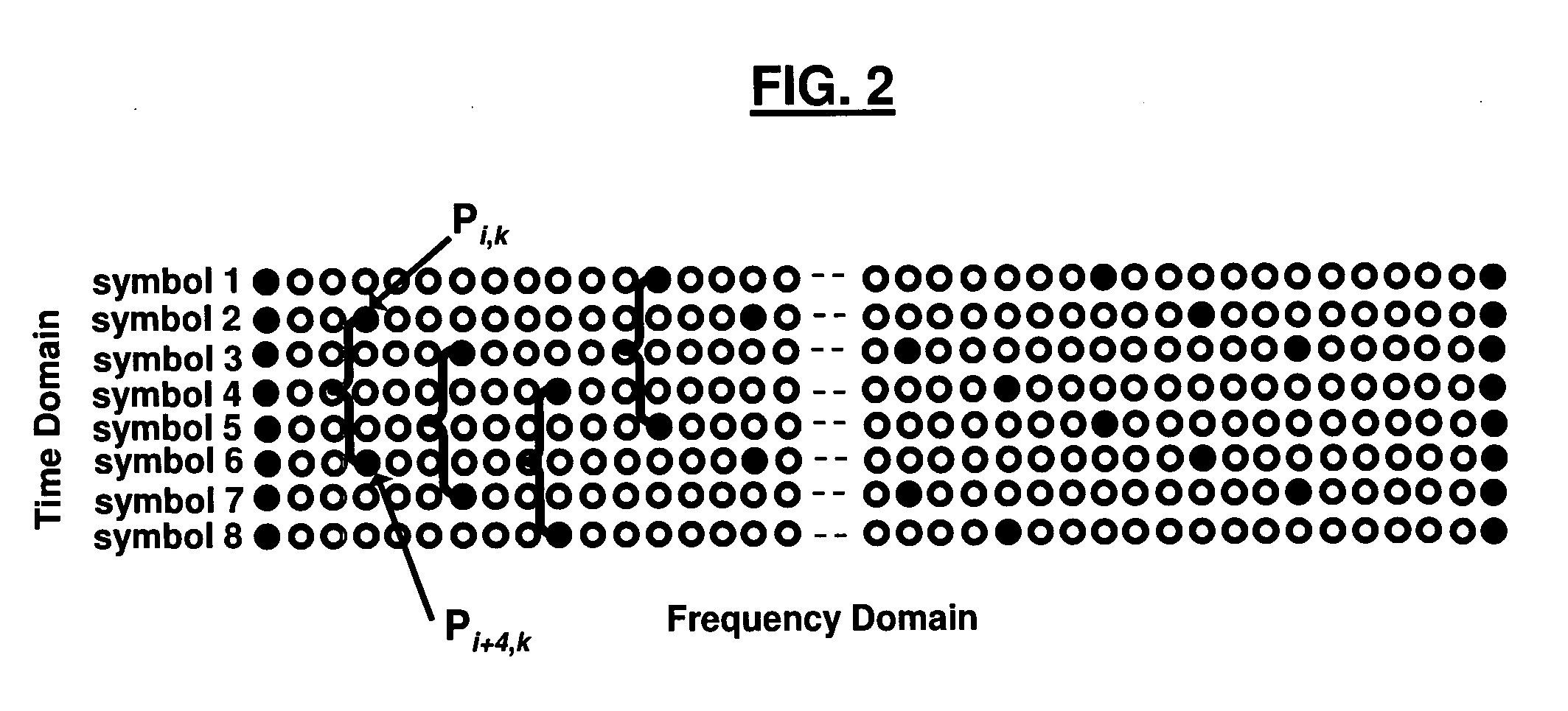Scattered pilot correlation in dvb-h systems
a pilot correlation and dvb-h technology, applied in the field of mobile television (tv) technologies, can solve problems such as wrong estimation of scattered pilot locations
- Summary
- Abstract
- Description
- Claims
- Application Information
AI Technical Summary
Problems solved by technology
Method used
Image
Examples
first embodiment
[0032] scattered pilot correlation may occur only in the time domain (across OFDM symbols). In other words, as illustrated in FIG. 2, the correlation occurs vertically. One way to detect the scattered pilot locations is to cross-correlate the two OFDM symbols with indices i and i+4 (i.e., OFDM symbols Pi,k and Pi+4,k). If P(i,k) is a given symbol, where i is the symbol index and k is the subcarrier number, then the cross-correlation equation is
C(i)=∑0KmaxP(i,k)·P*(i+4,k),
the maximum values of C(i) occurs if two terms of the cross-correlation are equal, which occurs at indices of scattered pilots, thus their location is detected.
[0033]If the channel is slow fading, the change in the subcarrier across four symbols can be ignored and the correlation sequence has peaks at the scattered pilot locations. In this context, a slow fading channel stays the same over the entire time-scale of communication. Slow fading arises when the coherence time of the channel (a measure of the minimum time...
second embodiment
[0036]Additionally, in a second embodiment, as shown in FIG. 5, the scattered pilot correlation may occur in both the time and frequency domains (across OFDM symbols and subcarriers). In other words, in FIG. 5, the correlation occurs diagonally. This technique uses one OFDM symbol buffer. The correlation occurs between current symbol and the next one; only one symbol is buffered thus its delay is small compared to the first method shown in FIG. 4. The OFDM symbol is cross-correlated with the next symbol. If P(i,k) is a given symbol, where i is the symbol index and k is the subcarrier number, then the cross-correlation equation is
C(i)=∑0KmaxP(i,k)·P*(i+1,k+3),
the maximum values of C(i) occurs if two terms of the cross-correlation are equal, which occurs at indices of the scattered pilots, thus their location is detected.
[0037]The difference in time is only one symbol (as compared to four symbols in the first embodiment) and the difference in subcarriers is only three subcarriers (as ...
third embodiment
[0039] as shown in FIG. 7, the scattered pilot correlation occurs only in the frequency domain (across subcarriers). In other words, in FIG. 7, the correlation occurs horizontally. For the same OFDM symbol, autocorrelation of the OFDM symbol results in peaks at the scattered pilot locations. One way to detect the scattered pilot locations is to cross-correlate the two OFDM symbols with indices k and k+12 (i.e., OFDM symbols Pi,k and Pi,k+12). The amplitudes of these peaks depend on how flat the channel is in frequency. For flat frequency channels (e.g., ideal or AWGN channels), the autocorrelation gives high peaks at the scattered pilot locations and the location detection technique is reliable. If P(i,k) is a given symbol, where i is the symbol index and k is the subcarrier number, then the cross-correlation equation is
C(i)=∑0KmaxP(i,k)·P*(i,k+12),
the maximum values of C(i) occurs if two terms of the cross-correlation are equal which occurs at indices of the scattered pilots, thus ...
PUM
 Login to View More
Login to View More Abstract
Description
Claims
Application Information
 Login to View More
Login to View More - R&D
- Intellectual Property
- Life Sciences
- Materials
- Tech Scout
- Unparalleled Data Quality
- Higher Quality Content
- 60% Fewer Hallucinations
Browse by: Latest US Patents, China's latest patents, Technical Efficacy Thesaurus, Application Domain, Technology Topic, Popular Technical Reports.
© 2025 PatSnap. All rights reserved.Legal|Privacy policy|Modern Slavery Act Transparency Statement|Sitemap|About US| Contact US: help@patsnap.com



